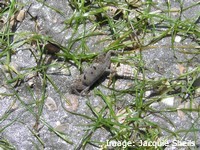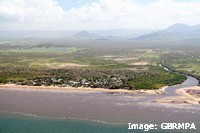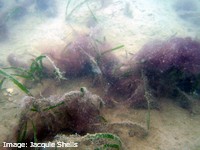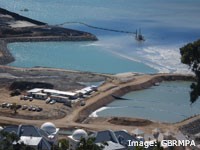













Flatback turtles
The Flatback turtle's scientific name, Natator depressus, comes from the Latin for ‘natator’ meaning swimmer, and ‘depressus’ meaning flat. This comes from the very low-domed shape of the Flatback’s shell.
Flatback turtles were once thought to be closely related to Green turtles and used to be included in the same scientific genus, but they are now the only species in the genus Natator.
The IUCN lists Flatback turtles as ‘Data Deficient’ which means that not enough information is available about this elusive species, which is listed as Vulnerable in Queensland and nationally.
As Australian as koalas
Flatback turtles are endemic to Australia; they only breed in Australia and unlike many sea turtles, most remain on the Australian Continental shelf throughout their life-cycle. They only nest on the beaches and islands of Queensland, the Northern Territory and Western Australia. Flatbacks feed along the Australian coast north of the Tropic of Capricorn and beyond to Indonesia and Papua New Guinea.
They live in coastal waters in soft sediment habitats such as seagrass beds, at depths of 6-35m, where they feed on soft bodied animals, including soft corals, sea pens, sea cucumbers, jellyfish, prawns and molluscs. They are primarily home-bodies, with the shortest migrations of any sea turtle, although some can move up to 1300km to breed. This makes them very dependant on local habitats for feeding and nesting.
Six separate populations of Flatback turtles have been identified. The East Coast population is estimated to be about 1000 turtles, the Whitsunday Region may support nesting for around 10% of this population.
How to recognise a Flatback
Flatbacks have a distinctive, low-domed shell with upturned edges. The top of the shell (carapace) is olive coloured and it is creamy yellow underneath. The shell is covered by soft skin, giving the turtle’s shell a smooth, leathery appearance, unlike most other sea turtles which have overlapping, hardened scale-like 'scutes,' like roof tiles, covering their upper surface.
Remarkable armour
Sea turtles evolved about 150 million years ago, in the age of the Dinosaurs, and their body design has been so successful that they have changed little since then. They have broad, flattened ribs that are joined to each other and are fused to the spine, and a broad bony plate under their bodies, producing a bony case that completely encloses everything except the turtle’s limbs and head. The internationally respected biologist Dr Alfred Sherwood Romer wrote in 1933:
‘Because they are still living, turtles are commonplace objects to us; were they extinct, their shells - the most remarkable armour ever assumed by a tetrapod (4 legged) animal – would be a cause for wonder’.
This protective case has served them well, as adult sea turtles have relatively few predators, apart from sharks, crocodiles and humans.
Traditional hunting
The meat and eggs of Flatback turtles have been a traditional food for Aboriginal and Torres Strait Islander people for thousands of years, although in most areas Green turtles are the main species that is hunted.
Turtle biology
Flatback turtles can grow to about 1.2m shell length and 90kg in weight. They are air-breathing reptiles and the length of time that they can stay submerged depends on their levels of stress and activity. Flatbacks can stay active below the surface of the water longer than other species of sea turtles but also spend quite a lot of time basking on the surface.
Like other sea turtles, they don’t need to drink fresh water because they can get rid of the excess salt from seawater through special ducts next to their eyes. When females are ashore laying eggs the salty secretion looks like tears.
Flatback Turtles in the Whitsundays
Most sandy beaches in the Mackay-Whitsunday region are potential turtle nesting sites. Nesting in the Whitsundays is between October and January, with hatchlings emerging between January and April. About 30-100 turtles nest in the region each year; most of these are Flatbacks. Mainland beaches in the Whitsunday region produce mainly female hatchlings, while the offshore islands mainly produce males.
Flatback turtles feed in the shallow protected waters around the Whitsunday Islands and nearby mainland coast. Because Flatbacks feed mainly in murky inshore waters, we don’t know very much about what they get up to underwater.
Not all beaches are created equal
Not every beach is right for nesting: for hatchlings to develop, the sand of the nesting beach must be well aerated, protected from flooding by tides or creeks, free of disturbance from storms and egg predators, not too salty, moist but not too wet, and between 25-33˚ C.
Flatback eggs are larger than other sea turtle eggs and may be more tolerant of high temperatures and drying out than other turtle eggs. The sex of hatchlings depends on the temperature of the sand that the eggs are buried in: boys are cool (all boys at or below 26˚ C) and girls are hot (all girls at or above 29˚ C). Nests with a range of temperatures in between produce a mixture of both sexes.
Making more Flatback turtles
Mass nesting of Flatbacks occurs on islands of the southern Great Barrier Reef and at Crab Island in the Torres Strait, but many flatbacks nest at low densities throughout the mainland and island beaches in the Great Barrier Reef region. Female Flatbacks repeatedly return to nest at the same beach where they hatched.
Flatback turtles gather to mate off their nesting beaches between September and November. Mating turtles are a common sight in sheltered bays around the Whitsunday islands and mainland coast at this time of year. Males hang around in the waters off the nesting beaches, waiting for a chance to mate with the females, who will store sperm from multiple males to fertilise each batch of eggs.
Females begin nesting at about 20 years old and they may continue to breed for over 20 years, although their lifespan is not known. Flatbacks nest every 2-3 years, laying up to three clutches of around 50 eggs, much less than other species of sea turtles, but producing larger hatchlings. Being bigger may help the hatchlings to escape crabs and other small predators.
This is the only species of sea turtle that does not have an oceanic stage in its life cycle: young Flatbacks stay on the Australian continental shelf, but despite this they are rarely seen and little is known about this part of their life cycle. Young flatbacks have many predators and probably less than three hatchlings in every thousand live to be adults.
'Survivor', turtle style
After 47-58 days, the hatchlings usually emerge en-mass, at dusk or at night, using their numbers and the cover of darkness to increase their chances of avoiding predators. Even so, large numbers are eaten by birds, and many more by fish, during their race for the open sea. Either in the egg or as they emerge and cross the beach, they somehow imprint chemical and positional information about where they are, to allow them to return as adults to breed.
Hatchlings are strongly attracted to white light that is low on the horizon, which would normally be light reflected from the sea and would attract them seawards. This instinct can get them into trouble when we put artificial lighting along shorelines, attracting them inland to a sticky end on roads or on the menu of suburban pets. Offshore lighting on resorts, port facilities and large-ship anchorages can also attract hatchlings and make them vulnerable to predators.
Hatchlings don’t sleep or eat during their first few days out of the nest, they live on the yolk sac from the egg that they swallowed before hatching. Young flatbacks spend their lives in the surface waters of the Great Barrier Reef Lagoon, feeding on planktonic animals. Many are eaten by large fish, sharks and sea eagles.
Turtles in trouble
Flatback turtles face numerous threats to their survival, including:
- Destruction of nests by introduced species such as feral pigs and dogs
- Disturbance and nest damage due to people, pets, vehicles and lights on nesting beaches
- Loss of feeding and breeding habitat due to coastal development
- Damage to the Flatback's soft-bottomed feeding habitats from anchoring and dredging
- Entanglement in, and ingestion of marine debris, especially plastics
- Discarded fishing gear; ('Ghost nets') and shark control nets trap and drown turtles.
- Turtles are accidentally caught in some fisheries, although measures to minimise by-catch of turtles such as Turtle Excluder Devices in trawl nets, are mandatory on the Great Barrier Reef
- Boats travelling fast through shallow seagrass areas which can hit and injure or kill turtles
- Climate change threatens turtles by changing the sea surface temperature, disrupting breeding cycles, altering sand temperatures of nesting beaches, disrupting sex ratios of hatchlings.
- Changes in sea level and storm frequency due to climate change threaten seagrass habitats that turtles depend on for food
- Overseas, in addition to the threats above, unsustainable hunting and collecting of eggs remains a threat to sea turtles.
How you can help Flatback turtles...
- Go slow for those below!! Sea turtles feed in shallow inshore waters: slow your boat speed and keep a good lookout to avoid striking turtles. If you can, travel at speed in deeper water, where there is less turtle activity
- Report stranded or dead sea turtles: call the marine Animal Stranding Hotline at RSPCA Qld 1300 ANIMAL (1300 264625)
- Avoid disturbing turtles on beaches during the nesting season and avoid using lights that might frighten females laying eggs or cause hatchlings to head inland
- Keep your dog under control on the beach during turtle nesting season
- Don’t drive vehicles in the dunes where turtles nest
- Support local programs to restore and protect turtle nesting and feeding habitat
- Support local programs to control feral animal pests
- Avoid littering the marine environment: pick up litter when you visit the beach, even if it isn’t yours!
- Water quality begins at home (and at work...)! Remember that the chemicals you use will ultimately end up in the sea. Use environmentally friendly chemicals; avoid artificial herbicides and pesticides if you can. If you have to use harmful chemicals, follow the instructions on the label carefully and avoid uses that might let chemicals wash into drains or waterways.
- Buy turtle-friendly seafood products: Australian prawn fishermen use turtle excluder devices on their trawl nets
- Check your crab pots regularly: turtles die when they become entangled in poorly designed or abandoned crab pots
- When you travel, don’t buy souvenirs made from turtles
- Support programs that conserve turtles in developing countries
More information:
GBRMPA Responsible Reef Practices:
Get involved: report turtle sightings:
Volunteer groups:
Sea Turtle Foundation (Townsville)
Downloadable resources:
Flatback Turtle (Natator depressus) Threatened Species Day fact sheet
GBRMPA Tropical Topics: Seagrass
GBRMPA Tropical Topics: Stories from the Blue Highway
Marine Animal Stranding Hotline poster
Australian Government brochure: Harmful Marine Debris
Looking after protected species in Queensland: a guide for recreational fishers
Looking after protected species in Queensland: a guide for commercial fishers
Websites:
Sea Turtle Foundation (Townsville)
IUCN Marine Turtle Specialist Group
Queensland Museum: Green turtles
DAFF Queensland: Turtle excluder devices
Looking after protected species in Queensland: a guide for commercial fishers
Reports:
A biological review of Australian Marine Turtles: Flatback turtle
Australian Government: Flatback Turtle
A biological review of Australian Marine Turtles
Recovery Plan for Marine Turtles in Queensland
Exploiting Marine Wildlife in Queensland: The Commercial Dugong and Marine Turtle Fisheries


